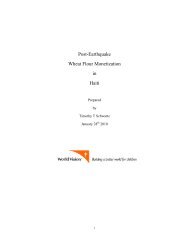Post Earthquake Jacmel (Haiti) Report and EMMA
Create successful ePaper yourself
Turn your PDF publications into a flip-book with our unique Google optimized e-Paper software.
18<br />
Figure 3: <strong>Haiti</strong>an sector of the Global Marketing System (for most imported staples)<br />
Foreign Agroindustrial<br />
producer<br />
Importer<br />
Wholesaler<br />
Komèsan<br />
(distributor)<br />
Rural market<br />
Urban market<br />
Marchan chita<br />
boutik (store )<br />
maket (super market)<br />
bo lari (roadside)<br />
I<br />
restaurant. Bakery….<br />
mpact: The physical blow that the earthquake dealt to the Global Market Economy, as it<br />
extends into <strong>Haiti</strong>, was principally to intermediate level warehouses in Port-au-Prince (many<br />
which were in the hard hit central city), to grocery stores (six of the city‘s 15 major grocery<br />
stores were damaged, at least two of which were leveled), <strong>and</strong> to bakeries.(several of the<br />
largest bakeries were put out of commission as well). Many of <strong>Jacmel</strong>‘s storage facilities were<br />
also damaged, giving an advantage to those komèsan who were not hit especially hard.<br />
The physical blow to the internal marketing market chain were the depòt mentioned<br />
earlier. But testimony to this market‘s resilience is that the rural <strong>and</strong> even many of the urban<br />
open markets never ceased operating. Two days after the earthquake, madam sara were<br />
walking down out of the mountains from the Southeast countryside <strong>and</strong> into Petion Ville<br />
(upper metropolitan Port-au-Prince). By the third day Petion Ville markets were functioning;<br />
prices for domestic produce had not increased. A principal complaint that peasants<br />
consistently made was the decline in urban market dem<strong>and</strong>. In retrospect this is lamentable as<br />
it did not have to be this way. What could have been a time of high market dem<strong>and</strong>, a moment<br />
when the peasants temporarily received high prices for rural produce, became instead one of<br />
low dem<strong>and</strong> <strong>and</strong> unchanging prices. People were not buying for the NGOs, foreign military<br />
forces, <strong>and</strong> religious missions who were rushing to save those under the rubble <strong>and</strong> to provide<br />
nourishment to the survivors had decided not to purchase locally, but instead to import food<br />
from abroad. The subsequent massive importation led to the paradoxical reverse, a different<br />
kind of crisis, a domestic market <strong>and</strong> local production crisis<br />
In summary, the vigorous internal <strong>Haiti</strong>an marketing system looms large in Southeast<br />
household livelihood strategies. Virtually all households are involved in the market system<br />
<strong>and</strong>, while about one third to one-half of most Southeast crops—including black beans-- are<br />
consumed by household members, the other portions get sold, the profits rolled over in<br />
internal marketing activities or in agricultural <strong>and</strong> livestock ventures, <strong>and</strong> eventually spent on<br />
food staples or necessities such as school tuition, medical care, or spiritual obligations to the<br />
family lwa <strong>and</strong> ancestors. Thus we can say that while farmers in the region are emphatically<br />
not subsistence farmers, they can expediently be defined as subsistence-oriented market<br />
producers <strong>and</strong> traders.
















